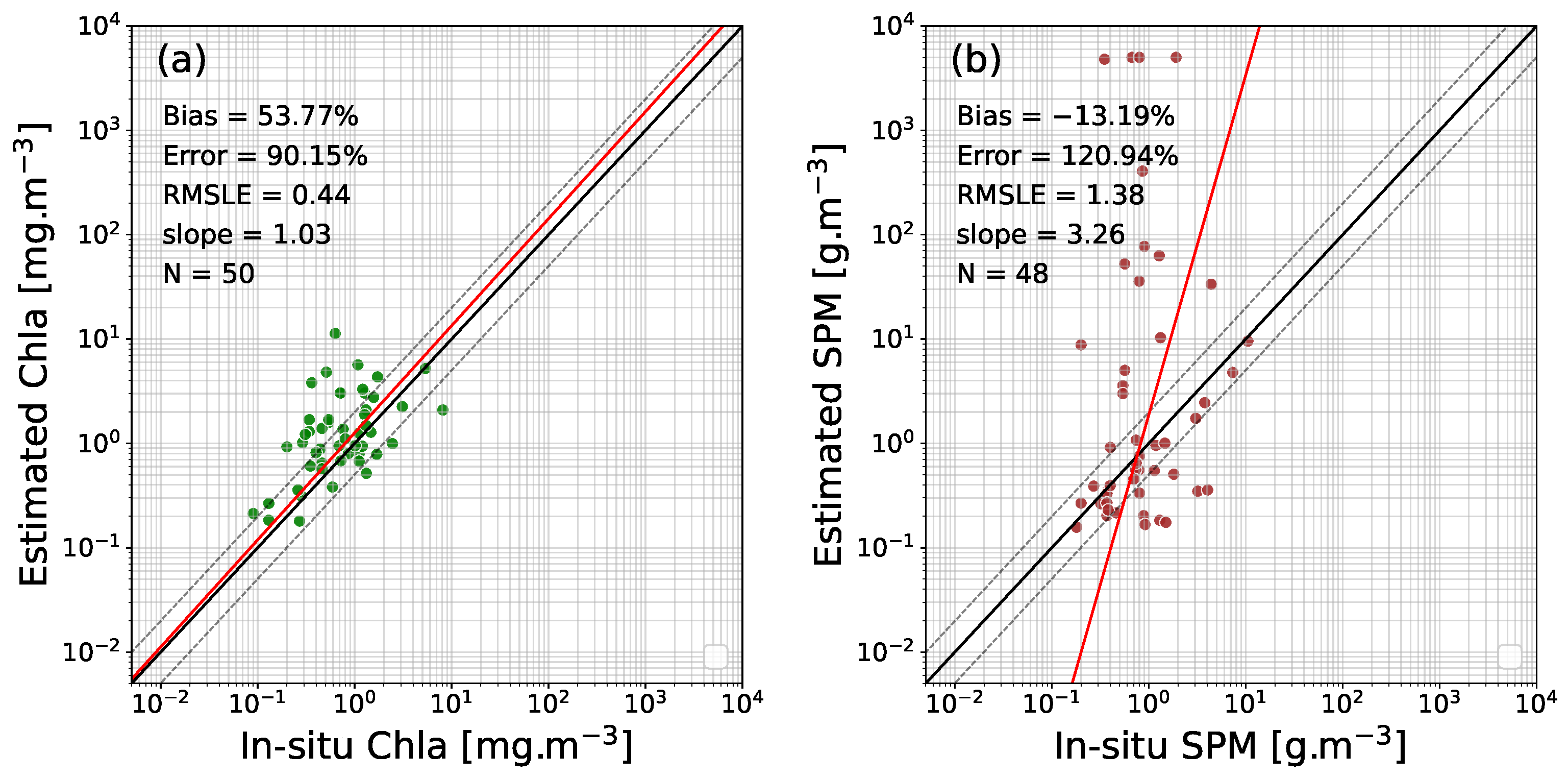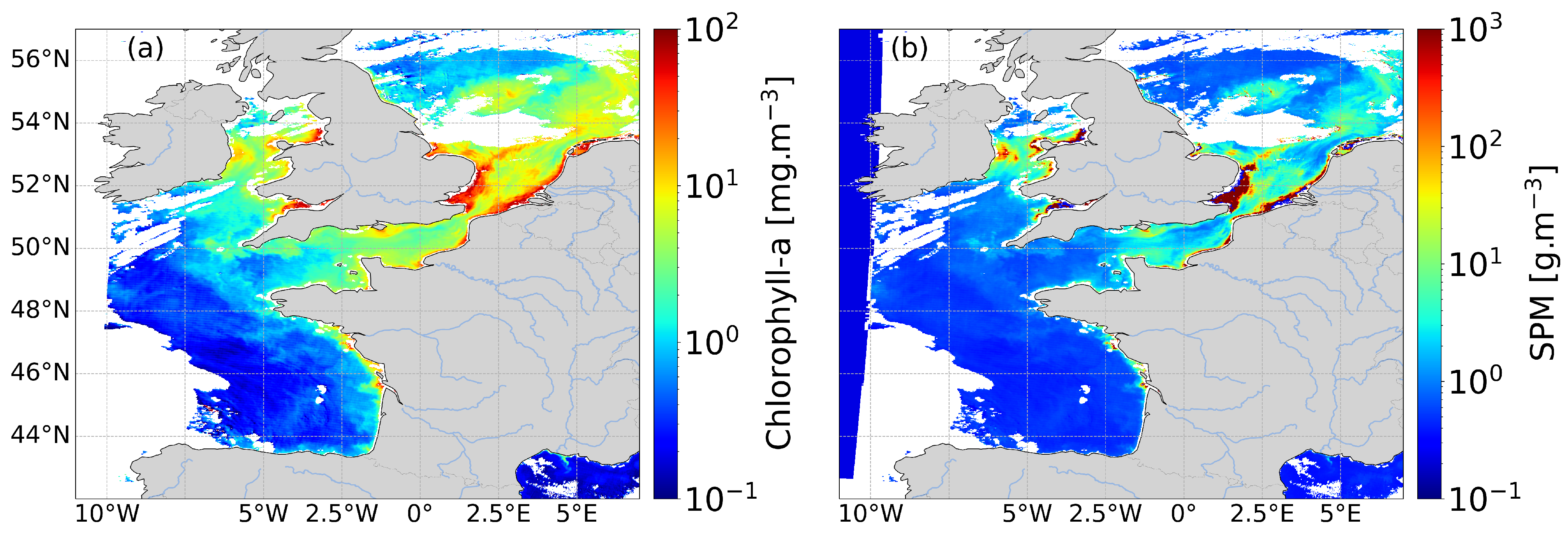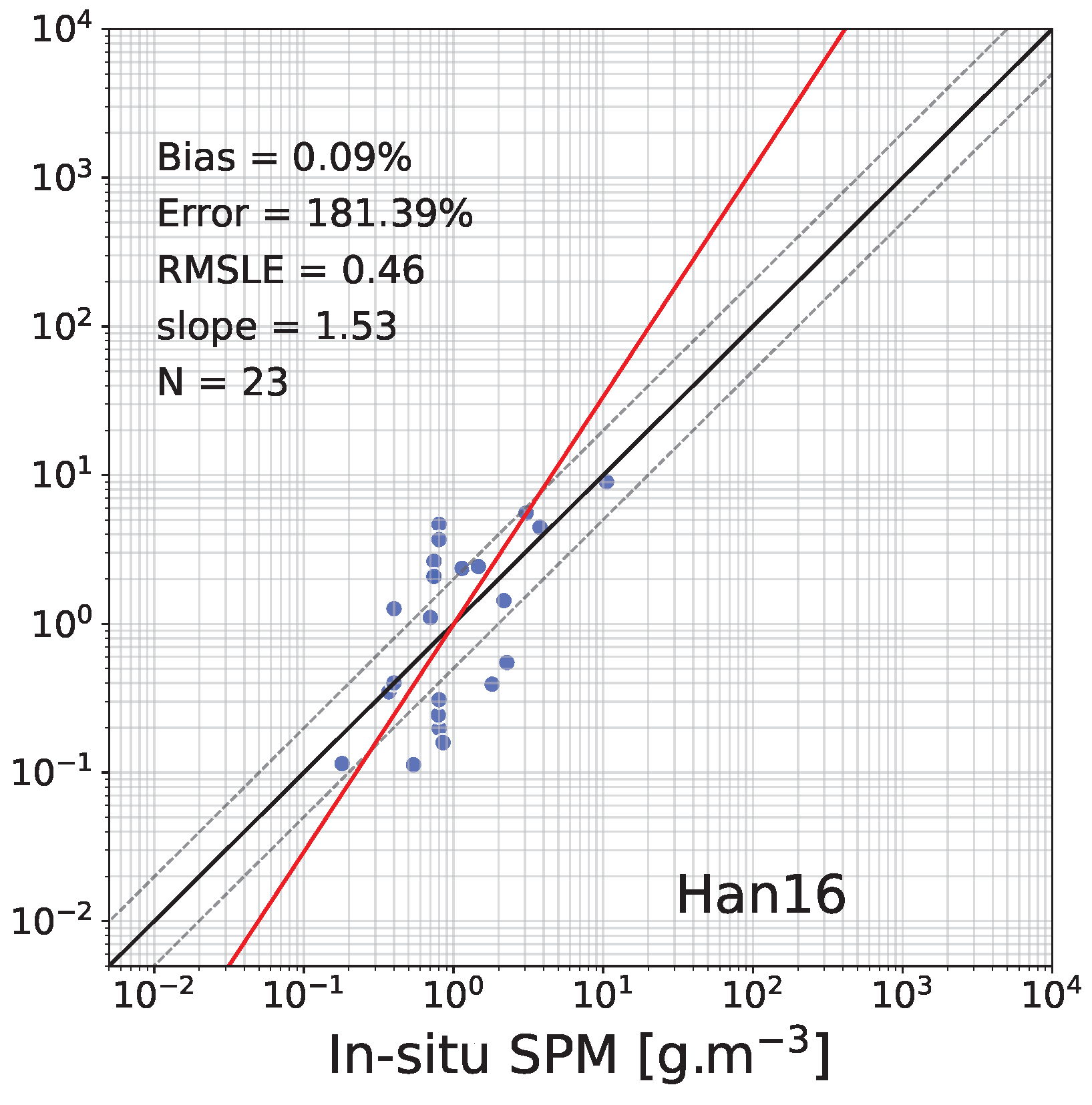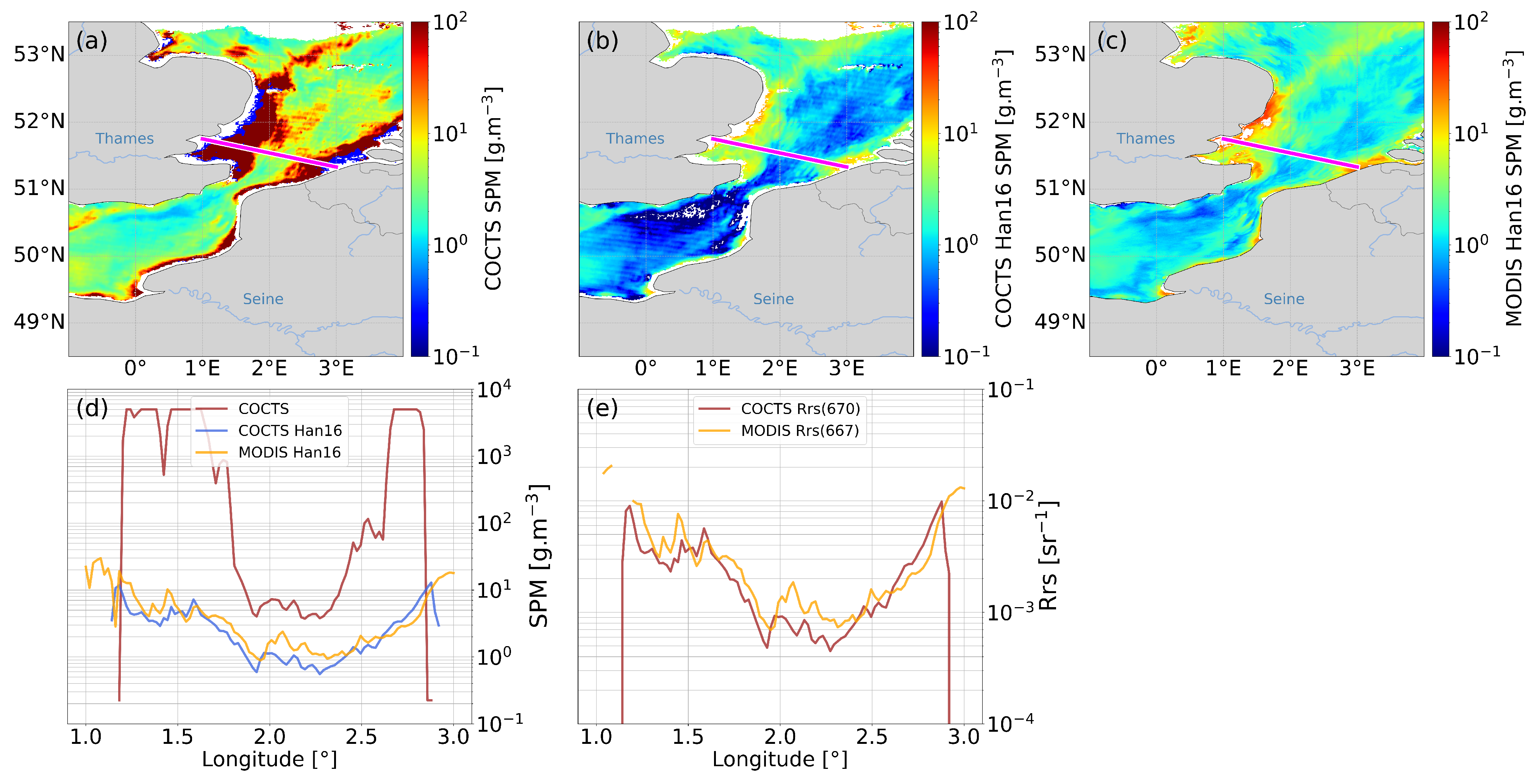Regional Assessment of COCTS HY1-C/D Chlorophyll-a and Suspended Particulate Matter Standard Products over French Coastal Waters
Abstract
1. Introduction
2. Materials and Methods
2.1. In Situ Data
2.2. Satellite Data
2.2.1. COCTS
2.2.2. MODIS
2.3. Matchup Methodology
2.4. Statistical Metrics
- Root mean square logarithmic error (“RMSLE”), quantifying the deviation of estimated values from the measured ones, incorporating a quadratic penalty for larger errors. Values closer to zero indicate better performance
- The Slope from a type II linear regression on the log-transformed data accounts for errors in both observed and estimated variables.
2.5. SPM Model Tested
3. Results
3.1. Matchup Exercise
3.2. Chla and SPM Maps Assessment
4. Discussion
4.1. A Stricter Matchup Exercise
4.2. Inter-Comparison with Another SPM Model
5. Conclusions
Author Contributions
Funding
Data Availability Statement
Acknowledgments
Conflicts of Interest
Abbreviations
| OCR | Ocean Color Radiometry |
| HY-1C/D | Haiyang-1C/D |
| Particulate backscattering coefficient | |
| CDOM | Colored dissolved organic matter |
| Chla | Chlorophyll-a |
| COCTS | Chinese Ocean Color and Temperature Scanner |
| MSA | Mean symmetric accuracy |
| NSOAS | National Satellite Ocean Application Service |
| Water leaving radiance | |
| RMSLE | Root mean squared logarithmic error |
| Remote sensing reflectance | |
| SOMLIT | Service d’Observation en Milieu Littoral |
| SPM | Suspended particulate matter |
| SSPB | Symmetric signed percentage bias |
References
- Tavora, J.; Boss, E.; Doxaran, D.; Hill, P. An Algorithm to Estimate Suspended Particulate Matter Concentrations and Associated Uncertainties from Remote Sensing Reflectance in Coastal Environments. Remote Sens. 2020, 12, 2172. [Google Scholar] [CrossRef]
- Hourany, R.E.; Mejia, C.; Faour, G.; Crépon, M.; Thiria, S. Evidencing the Impact of Climate Change on the Phytoplankton Community of the Mediterranean Sea Through a Bioregionalization Approach. J. Geophys. Res. Ocean. 2021, 126, e2020JC016808. [Google Scholar] [CrossRef]
- Loisel, H.; Duforêt-Gaurier, L.; Tran, T.K.; Jorge, D.S.F.; Steinmetz, F.; Mangin, A.; Bretagnon, M.; Fanton, O.H. Characterization of the Organic vs. Inorganic Fraction of Suspended Particulate Matter in Coastal Waters Based on Ocean Color Radiometry Remote Sensing; Copernicus Publications: Göttingen, Germany, 2023; Volume 1-osr7, pp. 1–12. [Google Scholar] [CrossRef]
- Cael, B.B.; Bisson, K.; Boss, E.; Dutkiewicz, S.; Henson, S. Global climate-change trends detected in indicators of ocean ecology. Nature 2023, 619, 551–554. [Google Scholar] [CrossRef] [PubMed]
- Antoine, D.; André, J.; Morel, A. Oceanic primary production: 2. Estimation at global scale from satellite (Coastal Zone Color Scanner) chlorophyll. Glob. Biogeochem. Cycles 1996, 10, 57–69. [Google Scholar] [CrossRef]
- Loisel, H.; Vantrepotte, V.; Ouillon, S.; Ngoc, D.D.; Herrmann, M.; Tran, V.; Mériaux, X.; Dessailly, D.; Jamet, C.; Duhaut, T.; et al. Assessment and analysis of the chlorophyll-a concentration variability over the Vietnamese coastal waters from the MERIS ocean color sensor (2002–2012). Remote Sens. Environ. 2017, 190, 217–232. [Google Scholar] [CrossRef]
- Pahlevan, N.; Smith, B.; Schalles, J.; Binding, C.; Cao, Z.; Ma, R.; Alikas, K.; Kangro, K.; Gurlin, D.; Hà, N.; et al. Seamless retrievals of chlorophyll-a from Sentinel-2 (MSI) and Sentinel-3 (OLCI) in inland and coastal waters: A machine-learning approach. Remote Sens. Environ. 2020, 240, 111604. [Google Scholar] [CrossRef]
- van Oostende, M.; Hieronymi, M.; Krasemann, H.; Baschek, B. Global ocean colour trends in biogeochemical provinces. Front. Mar. Sci. 2023, 10, 1052166. [Google Scholar] [CrossRef]
- Miller, R.L.; Cruise, J.F. Effects of suspended sediments on coral growth: Evidence from remote sensing and hydrologic modeling. Remote Sens. Environ. 1995, 53, 177–187. [Google Scholar] [CrossRef]
- Turner, A.; Millward, G.E. Suspended Particles: Their Role in Estuarine Biogeochemical Cycles. Estuarine Coast Shelf Sci. 2002, 55, 857–883. [Google Scholar] [CrossRef]
- Gernez, P.; Barillé, L.; Lerouxel, A.; Mazeran, C.; Lucas, A.; Doxaran, D. Remote sensing of suspended particulate matter in turbid oyster-farming ecosystems. J. Geophys. Res. Ocean. 2014, 119, 7277–7294. [Google Scholar] [CrossRef]
- Loisel, H.; Mangin, A.; Vantrepotte, V.; Dessailly, D.; Dinh, D.N.; Garnesson, P.; Ouillon, S.; Lefebvre, J.P.; Mériaux, X.; Phan, T.M. Variability of suspended particulate matter concentration in coastal waters under the Mekong’s influence from ocean color (MERIS) remote sensing over the last decade. Remote Sens. Environ. 2014, 150, 218–230. [Google Scholar] [CrossRef]
- Crossland, C.J.; Baird, D.; Ducrotoy, J.P.; Lindeboom, H.; Buddemeier, R.W.; Dennison, W.C.; Maxwell, B.A.; Smith, S.V.; Swaney, D.P. The Coastal Zone—A Domain of Global Interactions; Springer: Berlin/Heidelberg, Germany, 2005; pp. 1–37. [Google Scholar] [CrossRef]
- Gleason, M.G.; Reynolds, M.D.; Heady, W.N.; Easterday, K.; Morrison, S.A. The importance of identifying and protecting coastal wildness. Front. Conserv. Sci. 2023, 4, 1224618. [Google Scholar] [CrossRef]
- Melet, A.; Teatini, P.; Cozannet, G.L.; Jamet, C.; Conversi, A.; Benveniste, J.; Almar, R. Earth Observations for Monitoring Marine Coastal Hazards and Their Drivers. Surv. Geophys. 2020, 41, 1489–1534. [Google Scholar] [CrossRef]
- Serafy, G.Y.E.; Schaeffer, B.A.; Neely, M.B.; Spinosa, A.; Odermatt, D.; Weathers, K.C.; Baracchini, T.; Bouffard, D.; Carvalho, L.; Conmy, R.N.; et al. Integrating Inland and Coastal Water Quality Data for Actionable Knowledge. Remote Sens. 2021, 13, 2899. [Google Scholar] [CrossRef] [PubMed]
- Doxaran, D.; Lamquin, N.; Park, Y.J.; Mazeran, C.; Ryu, J.H.; Wang, M.; Poteau, A. Retrieval of the seawater reflectance for suspended solids monitoring in the East China Sea using MODIS, MERIS and GOCI satellite data. Remote Sens. Environ. 2014, 146, 36–48. [Google Scholar] [CrossRef]
- Loisel, H.; Vantrepotte, V.; Jamet, C.; Ngoc Dat, D. Challenges and New Advances in Ocean Color Remote Sensing of Coastal Waters. In Topics in Oceanography; InTech: Rijeka, Croatia, 2013. [Google Scholar] [CrossRef]
- Jiang, X.; Yin, X.; Guan, L.; Wang, Z.; Lv, L.; Liu, M. Global ocean observations and applications by China’s ocean satellite constellation. Intell. Mar. Technol. Syst. 2023, 1, 6. [Google Scholar] [CrossRef]
- Ye, X.; Liu, J.; Lin, M.; Ding, J.; Zou, B.; Song, Q. Global Ocean Chlorophyll-a Concentrations Derived from COCTS Onboard the HY-1C Satellite and Their Preliminary Evaluation. IEEE Trans. Geosci. Remote Sens. 2021, 59, 9914–9926. [Google Scholar] [CrossRef]
- Li, H.; He, X.; Ding, J.; Bai, Y.; Wang, D.; Gong, F.; Li, T. The Inversion of HY-1C-COCTS Ocean Color Remote Sensing Products from High-Latitude Seas. Remote Sens. 2022, 14, 5722. [Google Scholar] [CrossRef]
- Mao, Z.; Tao, B.; Chen, J.; Chen, P.; Hao, Z.; Zhu, Q.; Huang, H. A Layer Removal Scheme for Atmospheric Correction of Satellite Ocean Color Data in Coastal Regions. IEEE Trans. Geosci. Remote Sens. 2021, 59, 1382–1391. [Google Scholar] [CrossRef]
- Mao, Z.; Zhang, Y.; Tao, B.; Chen, J.; Hao, Z.; Zhu, Q.; Huang, H. The Atmospheric Correction of COCTS on the HY-1C and HY-1D Satellites. Remote Sens. 2022, 14, 6372. [Google Scholar] [CrossRef]
- Xu, Y.; He, X.; Bai, Y.; Wang, D.; Zhu, Q.; Ding, X. Evaluation of Remote-Sensing Reflectance Products from Multiple Ocean Color Missions in Highly Turbid Water (Hangzhou Bay). Remote Sens. 2021, 13, 4267. [Google Scholar] [CrossRef]
- Chen, S.; Du, K.; Lee, Z.; Liu, J.; Song, Q.; Xue, C.; Wang, D.; Lin, M.; Tang, J.; Ma, C. Performance of COCTS in Global Ocean Color Remote Sensing. IEEE Trans. Geosci. Remote Sens. 2021, 59, 1634–1644. [Google Scholar] [CrossRef]
- Gordon, H.R.; Wang, M. Retrieval of water-leaving radiance and aerosol optical thickness over the oceans with SeaWiFS: A preliminary algorithm. Appl. Opt. 1994, 33, 443–452. [Google Scholar] [CrossRef] [PubMed]
- Gordon, H.R.; Ahn, J.H. Evolution of Ocean Color Atmospheric Correction: 1970–2005. Remote Sens. 2021, 13, 5051. [Google Scholar] [CrossRef]
- O’Reilly, J.E.; Maritorena, S.; Mitchell, B.G.; Siegel, D.A.; Carder, K.L.; Garver, S.A.; Kahru, M.; McClain, C. Ocean color chlorophyll algorithms for SeaWiFS. J. Geophys. Res. Ocean. 1998, 103, 24937–24953. [Google Scholar] [CrossRef]
- O’Reilly, J.E.; Werdell, P.J. Chlorophyll algorithms for ocean color sensors—OC4, OC5 and OC6. Remote Sens. Environ. 2019, 229, 32–47. [Google Scholar] [CrossRef] [PubMed]
- Mélin, F.; Vantrepotte, V. How optically diverse is the coastal ocean? Remote Sens. Environ. 2015, 160, 235–251. [Google Scholar] [CrossRef]
- Gitelson, A.A.; Schalles, J.F.; Hladik, C.M. Remote chlorophyll-a retrieval in turbid, productive estuaries: Chesapeake Bay case study. Remote Sens. Environ. 2007, 109, 464–472. [Google Scholar] [CrossRef]
- Gurlin, D.; Gitelson, A.A.; Moses, W.J. Remote estimation of chl-a concentration in turbid productive waters—Return to a simple two-band NIR-red model? Remote Sens. Environ. 2011, 115, 3479–3490. [Google Scholar] [CrossRef]
- Tran, M.D.; Vantrepotte, V.; Loisel, H.; Oliveira, E.N.; Tran, K.T.; Jorge, D.; Mériaux, X.; Paranhos, R. Band Ratios Combination for Estimating Chlorophyll-a from Sentinel-2 and Sentinel-3 in Coastal Waters. Remote Sens. 2023, 15, 1653. [Google Scholar] [CrossRef]
- Gross, L.; Thiria, S.; Frouin, R.; Mitchell, B.G. Artificial neural networks for modeling the transfer function between marine reflectance and phytoplankton pigment concentration. J. Geophys. Res. Ocean. 2000, 105, 3483–3495. [Google Scholar] [CrossRef]
- D’Alimonte, D.; Zibordi, G. Phytoplankton determination in an optically complex coastal region using a multilayer perceptron neural network. IEEE Trans. Geosci. Remote Sens. 2003, 41, 2861–2868. [Google Scholar] [CrossRef]
- Nechad, B.; Ruddick, K.G.; Park, Y. Calibration and validation of a generic multisensor algorithm for mapping of total suspended matter in turbid waters. Remote Sens. Environ. 2010, 114, 854–866. [Google Scholar] [CrossRef]
- Jiang, D.; Matsushita, B.; Pahlevan, N.; Gurlin, D.; Lehmann, M.K.; Fichot, C.G.; Schalles, J.; Loisel, H.; Binding, C.; Zhang, Y.; et al. Remotely estimating total suspended solids concentration in clear to extremely turbid waters using a novel semi-analytical method. Remote Sens. Environ. 2021, 258, 112386. [Google Scholar] [CrossRef]
- Jiang, D.; Matsushita, B.; Pahlevan, N.; Gurlin, D.; Fichot, C.G.; Harringmeyer, J.; Sent, G.; Brito, A.C.; Brotas, V.; Werther, M.; et al. Estimating the concentration of total suspended solids in inland and coastal waters from Sentinel-2 MSI: A semi-analytical approach. ISPRS J. Photogramm. Remote Sens. 2023, 204, 362–377. [Google Scholar] [CrossRef]
- Han, B.; Loisel, H.; Vantrepotte, V.; Mériaux, X.; Bryère, P.; Ouillon, S.; Dessailly, D.; Xing, Q.; Zhu, J. Development of a Semi-Analytical Algorithm for the Retrieval of Suspended Particulate Matter from Remote Sensing over Clear to Very Turbid Waters. Remote Sens. 2016, 8, 211. [Google Scholar] [CrossRef]
- Balasubramanian, S.V.; Pahlevan, N.; Smith, B.; Binding, C.; Schalles, J.; Loisel, H.; Gurlin, D.; Greb, S.; Alikas, K.; Randla, M.; et al. Robust algorithm for estimating total suspended solids (TSS) in inland and nearshore coastal waters. Remote Sens. Environ. 2020, 246, 111768. [Google Scholar] [CrossRef]
- Mao, Z.; Chen, J.; Pan, D.; Tao, B.; Zhu, Q. A regional remote sensing algorithm for total suspended matter in the East China Sea. Remote Sens. Environ. 2012, 124, 819–831. [Google Scholar] [CrossRef]
- Moutier, W.; Thomalla, S.J.; Bernard, S.; Wind, G.; Ryan-Keogh, T.J.; Smith, M.E. Evaluation of Chlorophyll-a and POC MODIS Aqua Products in the Southern Ocean. Remote Sens. 2019, 11, 1793. [Google Scholar] [CrossRef]
- Delgado, A.L.; Pratolongo, P.D.; Dogliotti, A.I.; Arena, M.; Celleri, C.; Cardona, J.E.G.; Martinez, A. Evaluation of MODIS-Aqua and OLCI Chlorophyll-a products in contrasting waters of the Southwestern Atlantic Ocean. Ocean Coast. Res. 2021, 69, e21007. [Google Scholar] [CrossRef]
- Cao, Z.; Ma, R.; Pahlevan, N.; Liu, M.; Melack, J.M.; Duan, H.; Xue, K.; Shen, M. Evaluating and Optimizing VIIRS Retrievals of Chlorophyll-a and Suspended Particulate Matter in Turbid Lakes Using a Machine Learning Approach. IEEE Trans. Geosci. Remote Sens. 2022, 60, 4211417. [Google Scholar] [CrossRef]
- Subirade, C.; Jamet, C.; Duy Tran, M.; Vantrepotte, V.; Han, B. Evaluation of twelve algorithms to estimate suspended particulate matter from OLCI over contrasted coastal waters. Opt. Express 2024, 32, 45719–45744. [Google Scholar] [CrossRef]
- Yang, G.; Ye, X.; Xu, Q.; Yin, X.; Xu, S. Sea Surface Chlorophyll-a Concentration Retrieval from HY-1C Satellite Data Based on Residual Network. Remote Sens. 2023, 15, 3696. [Google Scholar] [CrossRef]
- Breton, E.; Savoye, N.; Rimmelin-Maury, P.; Sautour, B.; Goberville, E.; Lheureux, A.; Cariou, T.; Ferreira, S.; Agogué, H.; Alliouane, S.; et al. Data quality control considerations in multivariate environmental monitoring: Experience of the French coastal network SOMLIT. Front. Mar. Sci. 2023, 10, 1135446. [Google Scholar] [CrossRef]
- Bailey, S.W.; Werdell, P.J. A multi-sensor approach for the on-orbit validation of ocean color satellite data products. Remote Sens. Environ. 2006, 102, 12–23. [Google Scholar] [CrossRef]
- Goyens, C.; Jamet, C.; Schroeder, T. Evaluation of four atmospheric correction algorithms for MODIS-Aqua images over contrasted coastal waters. Remote Sens. Environ. 2013, 131, 63–75. [Google Scholar] [CrossRef]
- EUMETSAT. Recommendations for Sentinel-3 OLCI Ocean Colour Product Validations in Comparison with in situ Measurements–Matchup Protocols. EUM/SEN3/D. Technical Report v7, EUMETSAT, 2021. Available online: https://user.eumetsat.int/s3/eup-strapi-media/Recommendations_for_Sentinel_3_OLCI_Ocean_Colour_product_validations_in_comparison_with_in_situ_measurements_Matchup_Protocols_V8_B_e6c62ce677.pdf (accessed on 12 January 2025).
- Stumpf, R.P.; Loftin, K.A.; Werdell, P.J.; Seegers, B.N.; Schaeffer, B.A. Performance metrics for the assessment of satellite data products: An ocean color case study. Opt. Express 2018, 26, 7404–7422. [Google Scholar] [CrossRef] [PubMed]
- Leys, C.; Ley, C.; Klein, O.; Bernard, P.; Licata, L. Detecting outliers: Do not use standard deviation around the mean, use absolute deviation around the median. J. Exp. Soc. Psychol. 2013, 49, 764–766. [Google Scholar] [CrossRef]
- Morley, S.K.; Brito, T.V.; Welling, D.T. Measures of Model Performance Based On the Log Accuracy Ratio. Space Weather 2018, 16, 69–88. [Google Scholar] [CrossRef]
- Smith, B.; Pahlevan, N.; Schalles, J.; Ruberg, S.; Errera, R.; Ma, R.; Giardino, C.; Bresciani, M.; Barbosa, C.; Moore, T.; et al. A Chlorophyll-a Algorithm for Landsat-8 Based on Mixture Density Networks. Front. Remote Sens. 2021, 1, 623678. [Google Scholar] [CrossRef]
- Pahlevan, N.; Smith, B.; Alikas, K.; Anstee, J.; Barbosa, C.; Binding, C.; Bresciani, M.; Cremella, B.; Giardino, C.; Gurlin, D.; et al. Simultaneous retrieval of selected optical water quality indicators from Landsat-8, Sentinel-2, and Sentinel-3. Remote Sens. Environ. 2022, 270, 112860. [Google Scholar] [CrossRef]
- Weston, K.; Greenwood, N.; Fernand, L.; Pearce, D.J.; Sivyer, D.B. Environmental controls on phytoplankton community composition in the Thames plume, U.K. J. Sea Res. 2008, 60, 262–270. [Google Scholar] [CrossRef]
- Uncles, R.J.; Mitchell, S.B. Turbidity in the Thames Estuary: How turbid do we expect it to be? Hydrobiologia 2011, 672, 91–103. [Google Scholar] [CrossRef]
- Guézennec, L.; Lafite, R.; Dupont, J.P.; Meyer, R.; Boust, D. Hydrodynamics of suspended particulate matter in the tidal freshwater zone of a macrotidal estuary (the Seine Estuary, France). Estuaries 1999, 22, 717–727. [Google Scholar] [CrossRef]
- Cao, Z.; Hu, C.; Ma, R.; Duan, H.; Liu, M.; Loiselle, S.; Song, K.; Shen, M.; Liu, D.; Xue, K. MODIS observations reveal decrease in lake suspended particulate matter across China over the past two decades. Remote Sens. Environ. 2023, 295. [Google Scholar] [CrossRef]
- Vantrepotte, V.; Loisel, H.; Dessailly, D.; Mériaux, X. Optical classification of contrasted coastal waters. Remote Sens. Environ. 2012, 123, 306–323. [Google Scholar] [CrossRef]
- Bricker, S.; Longstaff, B.; Dennison, W.; Jones, A.; Boicourt, K.; Wicks, C.; Woerner, J. Effects of nutrient enrichment in the nation’s estuaries: A decade of change. Harmful Algae 2008, 8, 21–32. [Google Scholar] [CrossRef]
- Bilotta, G.S.; Brazier, R.E. Understanding the influence of suspended solids on water quality and aquatic biota. Water Res. 2008, 42, 2849–2861. [Google Scholar] [CrossRef] [PubMed]
- Kroon, F.J.; Kuhnert, P.M.; Henderson, B.L.; Wilkinson, S.N.; Kinsey-Henderson, A.; Abbott, B.; Brodie, J.E.; Turner, R.D. River loads of suspended solids, nitrogen, phosphorus and herbicides delivered to the Great Barrier Reef lagoon. Mar. Pollut. Bull. 2012, 65, 167–181. [Google Scholar] [CrossRef] [PubMed]






Disclaimer/Publisher’s Note: The statements, opinions and data contained in all publications are solely those of the individual author(s) and contributor(s) and not of MDPI and/or the editor(s). MDPI and/or the editor(s) disclaim responsibility for any injury to people or property resulting from any ideas, methods, instructions or products referred to in the content. |
© 2025 by the authors. Licensee MDPI, Basel, Switzerland. This article is an open access article distributed under the terms and conditions of the Creative Commons Attribution (CC BY) license (https://creativecommons.org/licenses/by/4.0/).
Share and Cite
Subirade, C.; Jamet, C.; Han, B. Regional Assessment of COCTS HY1-C/D Chlorophyll-a and Suspended Particulate Matter Standard Products over French Coastal Waters. Remote Sens. 2025, 17, 2516. https://doi.org/10.3390/rs17142516
Subirade C, Jamet C, Han B. Regional Assessment of COCTS HY1-C/D Chlorophyll-a and Suspended Particulate Matter Standard Products over French Coastal Waters. Remote Sensing. 2025; 17(14):2516. https://doi.org/10.3390/rs17142516
Chicago/Turabian StyleSubirade, Corentin, Cédric Jamet, and Bing Han. 2025. "Regional Assessment of COCTS HY1-C/D Chlorophyll-a and Suspended Particulate Matter Standard Products over French Coastal Waters" Remote Sensing 17, no. 14: 2516. https://doi.org/10.3390/rs17142516
APA StyleSubirade, C., Jamet, C., & Han, B. (2025). Regional Assessment of COCTS HY1-C/D Chlorophyll-a and Suspended Particulate Matter Standard Products over French Coastal Waters. Remote Sensing, 17(14), 2516. https://doi.org/10.3390/rs17142516





